Detection of Stress Distribution in Surrounding Rock of Coal Seam Roadway Based on Charge Induction Principle
Abstract
:1. Introduction
2. Stress Distribution in Coal Body Mining
3. Mechanism of Charge Generation in Stress-Activated Coals
4. Theoretical Analysis of the Relationship between Charge Induction Intensity and Stress Level
5. Charge Induction Law Test for Graded Loading Coal Bodies
5.1. Specimen Preparation
5.2. Experiment System
5.3. Experiment Methods and Steps
5.4. Test Results and Analyses
6. Stress Distribution Charge Detection Test of Roadway Surrounding Rock
6.1. Charge-Monitoring Equipment
6.2. Monitoring Site and Monitoring Point Layout
6.3. Monitoring Results and Analysis
7. Discussion and Conclusions
- The coal sample has charge and acoustic emission during the step loading process, and the magnitude of the induced charge and acoustic emission energy is in good agreement with the stress level. The charge induction signal is more sensitive to the high stress of constant load, which can indirectly reflect the stress level of the coal body.
- The induced charge is small when the drilling depth of the solid coal side seam is 1~4 m. When the drilling depth is 5~9 m, the induced charge increases significantly. When the drilling depth is more than 9 m, the induced charge is smaller and then is stable. With the increase in drilling depth, the inductive signal of charge on the solid coal side has a wave peak, the position of the wave peak is 8~9 m from the roadway, and the stress concentration coefficient is 1.3~1.4.
- The induced charge is small when the drilling depth of the coal seam on the side of the coal pillar is 1~4 m. When the drilling depth is 5~7 m, the induced charge increases significantly. When the drilling depth is more than 7 m, the induced charge is smaller and then increases steadily. With the increase in drilling depth, the charge induction signal on the side of the coal pillar has a secondary wave peak, and the position of the first wave peak is 7 m from the roadway with a stress concentration factor of 1.6.
- With the increase in drilling depth, the amount of induced charge and drill cuttings per meter is in good agreement with the stress distribution in the roadway perimeter rock, and the location of the peak charge and drill cuttings is in agreement with the reflected stress concentration factor. Compared with the drilling chip method, charge induction technology has the advantages of being portable and non-contact, with high inspection efficiency and no disruption to production.
- By analyzing the size and position of charges at various borehole depths, the depth of the plastic zone and the peak area of lateral abutment pressure can be determined. This analysis provides targeted guidance for preventing and controlling coal and rock dynamic disasters, such as rock burst.
Author Contributions
Funding
Data Availability Statement
Conflicts of Interest
References
- Pan, Y.S.; Wang, A.W. Disturbance response instability theory of rock bursts in coal mines and its application. Geohazard Mech. 2023, 1, 1–17. [Google Scholar] [CrossRef]
- Liu, Q.; Li, J.L.; Liang, B.; Liu, J.; Sun, W.J.; He, J.; Lei, Y. Complex wettability behavior triggering mechanism on imbibition: A model construction and comparative study based on analysis at multiple scales. Energy 2023, 275, 127434. [Google Scholar] [CrossRef]
- Sabapathy, R.; Paul, P.S.; Mandal, P.K. Evaluation of bump-proneness of underground coal mines using burst energy coefficient. Arab. J. Geosci. 2019, 12, 579. [Google Scholar] [CrossRef]
- Zhao, R.; Tao, M.; Zhao, H.T.; Wu, C.Q.; Cao, W.Z. Theoretical study on dynamic stress redistribution around circular tunnel with different unloading paths. Comput. Geotech. 2023, 163, 105737. [Google Scholar] [CrossRef]
- Konicek, P.; Ptacek, J.; Waclawik, P.; Kajzar, V. Long-term Czech experiences with rockbursts with applicability to today’s underground coal mines. Rock Mech. Rock Eng. 2019, 52, 1447–1458. [Google Scholar] [CrossRef]
- Qiao, Z.; Li, C.W.; Wang, Q.F.; Xu, X.M. Principles of formulating measures regarding preventing coal and gas outbursts in deep mining: Based on stress distribution and failure characteristics. Fuel 2024, 356, 129578. [Google Scholar] [CrossRef]
- He, X.Q.; Wang, E.Y.; Zhang, R.G.; Liu, M.J. Determination of coal rock unloading zones using coal rock damage electromagnetic radiation characteristics. Saf. Coal Mines 1996, 2, 17–19. [Google Scholar] [CrossRef]
- Tian, X.; Song, D.; He, X.; Liu, H.; Wang, W.; Li, Z. Investigation of micro-surface potential of coals with different metamorphism by AFM. Measurement 2021, 172, 108915. [Google Scholar] [CrossRef]
- Fehdi, C.; Nouioua, I.; Belfar, D.; Djabri, L.; Salameh, E. Detection of underground cavities by combining electrical resistivity imaging and ground penetrating radar surveys: A Case Study from Draa Douamis Area (North East of Algeria). In H2Karst Research in Limestone Hydrogeology; Environmental Earth Sciences; Springer: Cham, Switzerland, 2014. [Google Scholar] [CrossRef]
- Kolesnikov, Y.I.; Fedin, K.V. Detecting underground cavities using microtremor data: Physical modelling and field experiment. Geophys. Prospect. 2018, 66, 342–353. [Google Scholar] [CrossRef]
- Laurent, A.; Leparoux, D.; Capdeville, Y.; Durand, O. Detectability of underground cavities by surface seismic waves using das fiber optic recordings: Feasibility Analysis. In Proceedings of the NSG2022 28th European Meeting of Environmental and Engineering Geophysics, Belgrade, Serbia, 18–22 September 2022. [Google Scholar] [CrossRef]
- Xia, H.Q.; Jiang, S.X. Geostress effect on resistivity and its relevant correction method. Petroleum 2023, 9, 412–418. [Google Scholar] [CrossRef]
- Choi, J.-R.; Kim, S.-S.; Park, S.-K.; Shin, K.-S.; Kang, B.-C. A case study of electrical resistivity and borehole imaging methods for detecting underground cavities and monitoring ground subsidence at abandoned underground mines. J. Korean Earth Sci. Soc. 2013, 34, 195–208. [Google Scholar] [CrossRef]
- Jiang, Q.; Feng, X.T.; Su, G.S.; Chen, G. Intelligent back analysis of rock mass parameters for large underground caverns under high earth stress. Chin. J. Rock Mech. Eng. 2007, 26, 2654–2662. [Google Scholar]
- Ma, S.L.; Zhang, M.W.; Ma, L.; Tian, Z.C.; Li, X.; Su, Z.H.; Bian, S.C. Experimental investigation on stress distribution and migration of the overburden during the mining process in deep coal seam mining. Geoenviron. Disasters 2023, 10, 24. [Google Scholar] [CrossRef]
- Gao, L.; Zhao, S.H.; Zhan, X.Y.; Zhao, Z.Q.; Liu, P.Z.; Wang, Y.; Liu, P. Stress distribution characteristics of the surrounding rock of the gob-side coal–rock roadway in a gently inclined coal seam under the influence of excavation and mining disturbance based on infrared detection. Int. J. Geomech. 2023, 23, 12. [Google Scholar] [CrossRef]
- Ju, Y.; Nie, X.D.; Zhu, Y.; Wang, K.; Zhou, H.W.; Ge, S. Stress distribution and roof subsidence of surrounding strata considering in situ coal conversion and CO2 mineralization backfilling: Photoelastic experiments using 3D-printed models of mining faces and goafs. Sci. Total Environ. 2024, 912, 169368. [Google Scholar] [CrossRef]
- Li, D.X.; Wang, E.Y.; Yue, J.H.; Zhang, X.; Wang, D.M.; Ju, Y.Q. A weak current technique for coal and rock dynamic disaster prediction and its application. Chin. J. Rock Mech. Eng. 2022, 41, 764–774. [Google Scholar] [CrossRef]
- Li, D.; Wang, E.; Li, Z.; Ju, Y.; Wang, D.; Wang, X. Experimental investigations of pressure stimulated currents from stressed sandstone used as precursors to rock fracture. Int. J. Rock Mech. Min. Sci. 2021, 145, 104841. [Google Scholar] [CrossRef]
- Zhao, Y.S.; Liang, C.S.; Liu, C.D. Exploration of drill chip method to measure the pressure of envelope rock. YanTu GongCheng XueBao 1987, 9, 104–110. [Google Scholar]
- Nitson, U. Electromagnetic emission accompanying fracture of quartz-bearing rocks. Geophys. Res. Lett. 1977, 4, 333–336. [Google Scholar] [CrossRef]
- Kuksenko, V.S.; Makhmudov, K.F.; Ponomarev, A.V. Relaxation of electric fields induced by mechanical loading in natural dielectrics. Phys. Solid State 1997, 39, 1065–1066. [Google Scholar] [CrossRef]
- Cress, G.O.; Brady, B.T.; Rowell, G.A. Sources of electromagnetic radiation from fracture of rock samples in laboratory. Geophys. Res. Lett. 1987, 14, 331–334. [Google Scholar] [CrossRef]
- Kirikaev. Electric Field of Rock under Force Loading; Xu, Y., Translator; Beijing Earthquake Press: Beijing, China, 1993. [Google Scholar]
- Triantis, D.; Anastasiadis, C.; Stavrakas, I. The correlation of electrical charge with strain on stressed rock samples. Nat. Hazards Earth Syst. Sci. 2008, 8, 1243–1248. [Google Scholar] [CrossRef]
- Triantis, D.; Stavrakas, I.; Anastasiadis, C.; Kyriazopoulos, A.; Vallianatos, F. An analysis of pressure stimulated currents (PSC), in marble samples under mechanical stress. Phys. Chem. Earth 2006, 31, 234–239. [Google Scholar] [CrossRef]
- Stavrakas, I.; Anastasiadis, C.; Triantis, D.; Vallianatos, F. Piezo stimulated currents in marble samples: Precursory and concurrent-with-failure signals. Nat. Hazards Earth Syst. 2003, 3, 243–247. [Google Scholar] [CrossRef]
- Vallianatos, F.; Tzanis, A. Electric current generation associated with the deformation rate of a solid: Preseismic and coseismic signals. Phys. Chem. Earth 1998, 23, 933–939. [Google Scholar] [CrossRef]
- Vallianatos, F.; Tzanis, A. A model for the generation of precursory electric and magnetic fields associated with the deformation rate of the earthquake focus. In Seismic Atmospheric & Ionospheric Electromagnetic Phenomena; Hayakawa, M., Ed.; Terra Scientific Publishing Co.: Tokyo, Japan, 1999; Available online: https://cir.nii.ac.jp/crid/1571698599922647424 (accessed on 30 June 2017).
- Vallianatos, F.; Triantis, D.; Tzanis, A.; Anastasiadis, C.; Stavrakas, I. Electric earthquake precursors: From laboratory results to field observations. Phys. Chem. Earth 2004, 29, 339–351. [Google Scholar] [CrossRef]
- Pan, Y.S.; Luo, H.; Xiao, X.C.; Zhao, Y.F.; Li, Z.H. Experimental study on mechanical charge induction law of coal containing gas under triaxial compression. China Coal Soc. 2012, 37, 918–922. [Google Scholar] [CrossRef]
- Pan, Y.S.; Luo, H.; Tang, Z.; Li, Z.H.; Zhao, Y.F. Study on the charge induction law of tensile instability damage of coal rock body. J. Rock Mech. Eng. 2013, 32, 1297–1303. [Google Scholar]
- Zhao, Y.F.; Jing, G.; Fan, Y.; Pan, Y. Experimental study on the microseism and charge signal time-frequency characteristics in the process of fault stick-slip instability. Chin. J. Rock Mech. Eng. 2020, 39, 1385–1395. [Google Scholar] [CrossRef]
- Zhao, Y.F.; Jing, G.; Cheng, C.J.; Li, B. Tests for fracture characteristics of fractured sandstone and micro-seismic and charge induced signal laws. J. Vib. Shock 2020, 39, 211–219. [Google Scholar] [CrossRef]
- Lyu, J.G.; Wang, Z.Q.; Yang, T.; Tang, Z.; Pan, Y.S.; Peng, Y.S. The relationship between storage-dissipation-release of coal energy and intensity of induced charge. Constr. Build. Mater. 2022, 357, 129375. [Google Scholar] [CrossRef]
- Wang, G.; Pan, Y.S.; Xiao, X.C.; Wu, D.; Zhao, H.R.; Wang, A.W.; Ding, X. Study on the relationship between stress and charge of coal mass under uniaxial compression. Shock Vib. 2019, 12, 9412697. [Google Scholar] [CrossRef]
- Wang, G.; Pan, Y.S.; Xiao, X.C. Research on damage characteristics and charge law of uniaxially loaded coal body and its application. Chin. Geotech. 2019, 40, 1823–1831. [Google Scholar] [CrossRef]
- Ding, X.; Xiao, X.-C.; Wu, D.; Lv, X.-F. Mechanical properties and charge signal characteristics in coal material failure under different loading paths. Int. J. Coal Sci. Technol. 2019, 6, 138–149. [Google Scholar] [CrossRef]
- Lyu, J.G.; Peng, Y.S.; Tang, Z.; Zhao, H.; Wang, X.; Wang, Z.; Bao, X.; Fu, H. Recognition of induced charge in coal failure process and its practice of underground application. J. China Coal Soc. 2022, 47, 1547–1558. [Google Scholar] [CrossRef]
- Pan, Y.S.; Zhao, Y.F.; Fu, L.; Li, G.; Ji, C. Rock Charge Radiometer. CN101487901B, 4 August 2010. [Google Scholar]
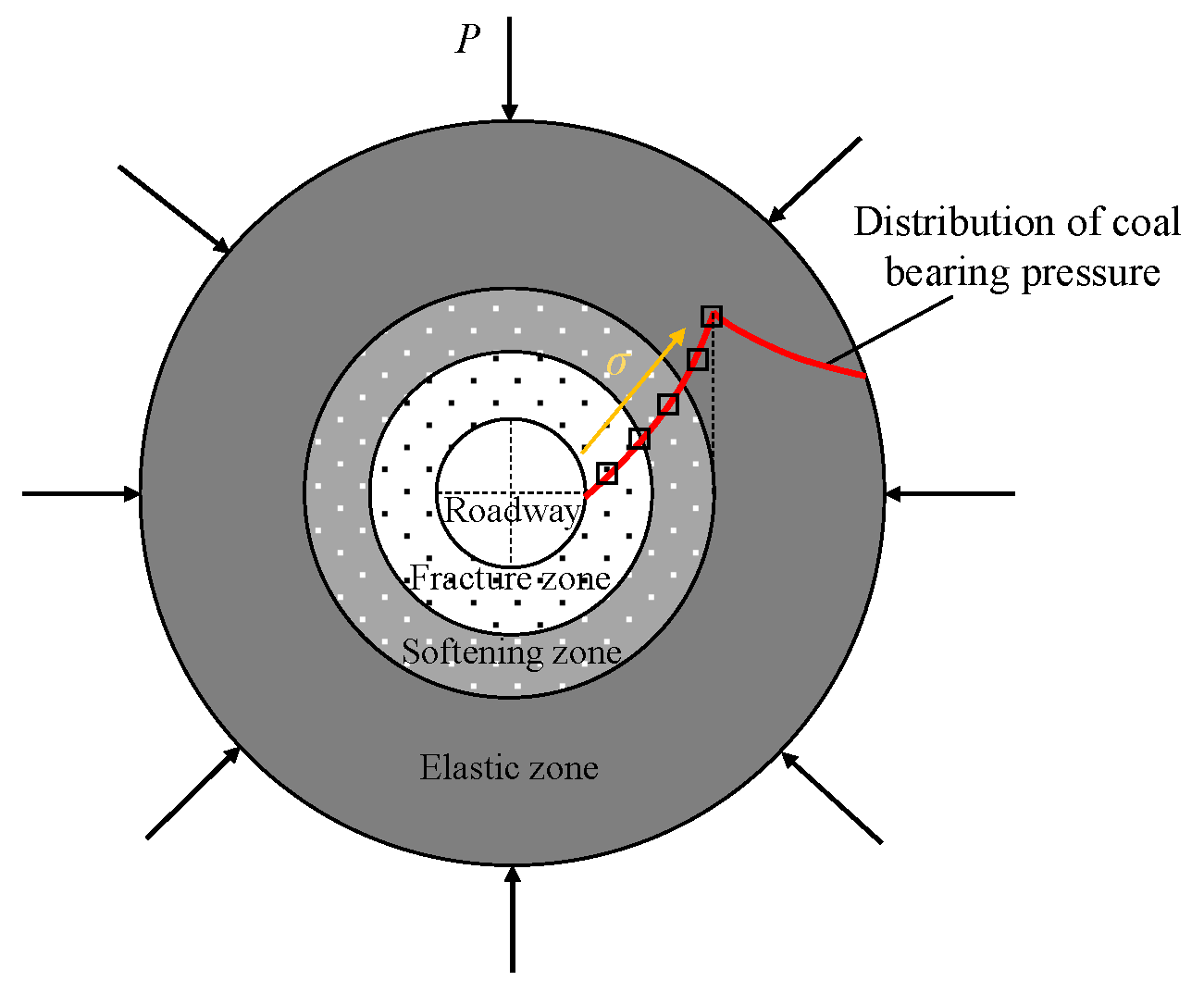



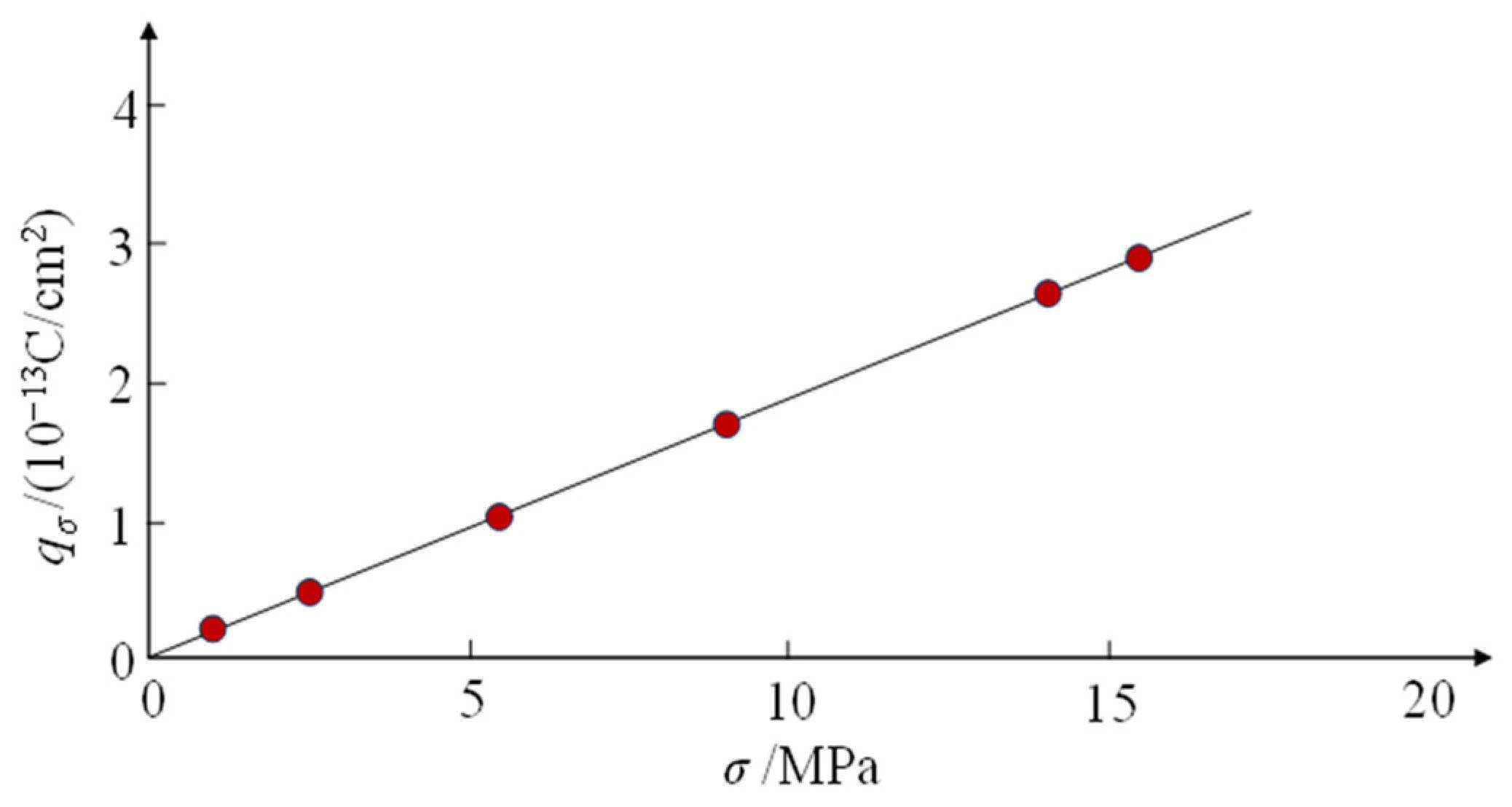
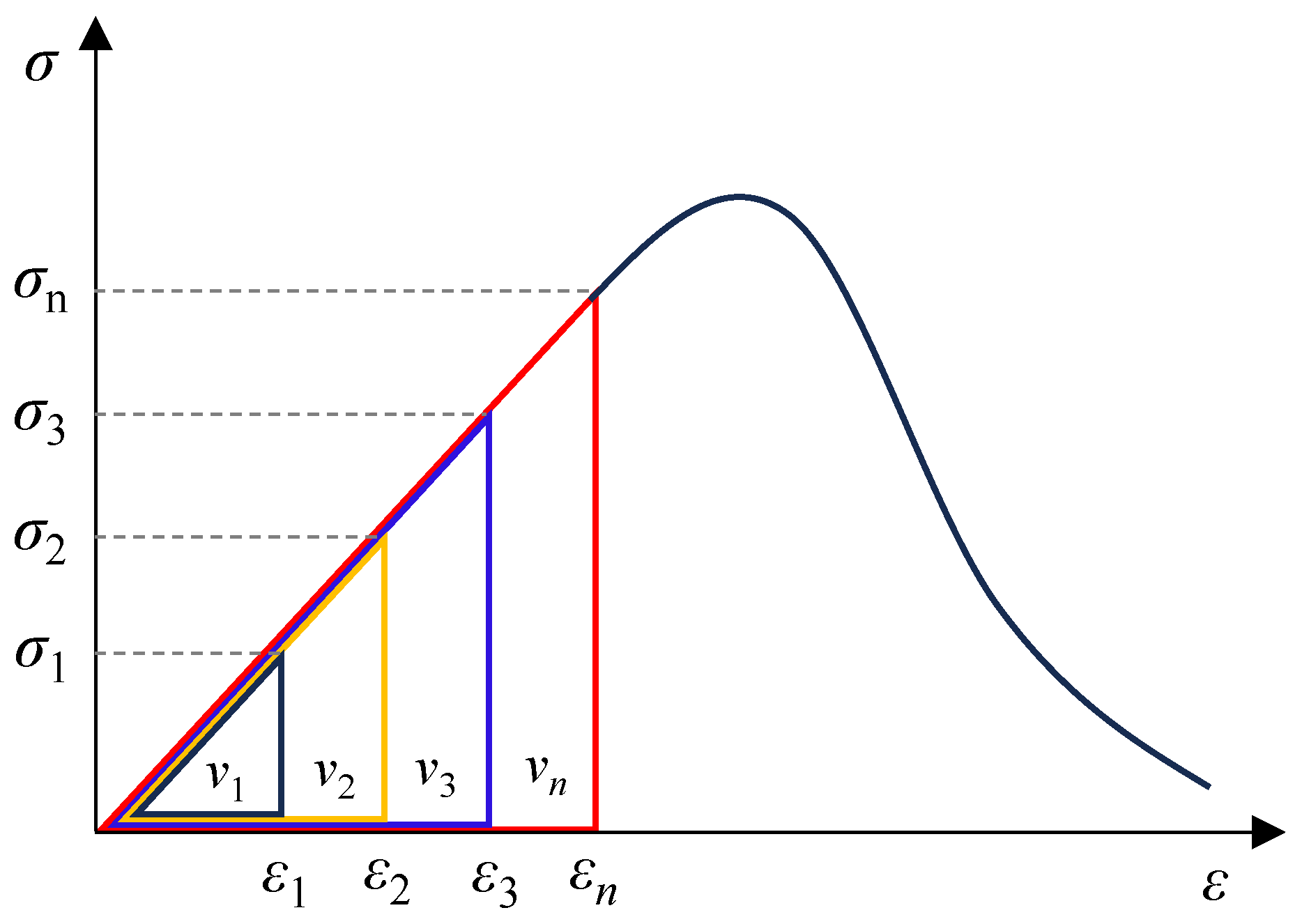
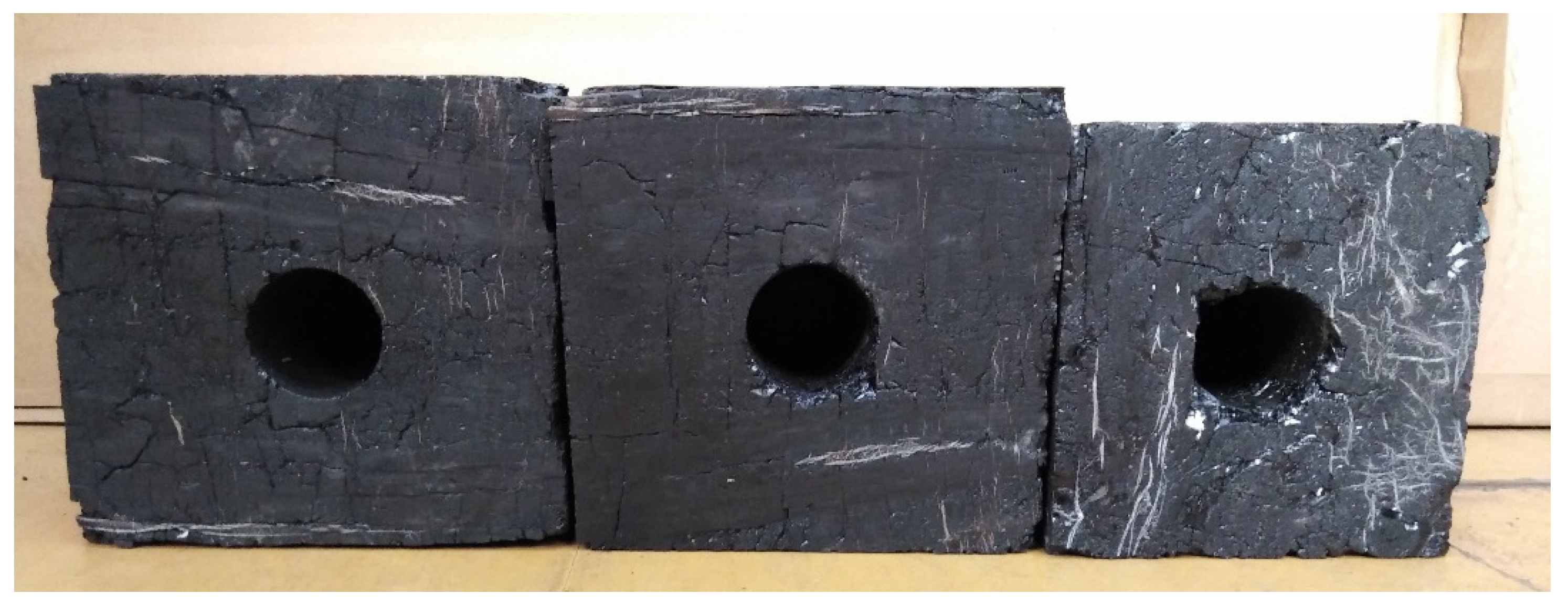
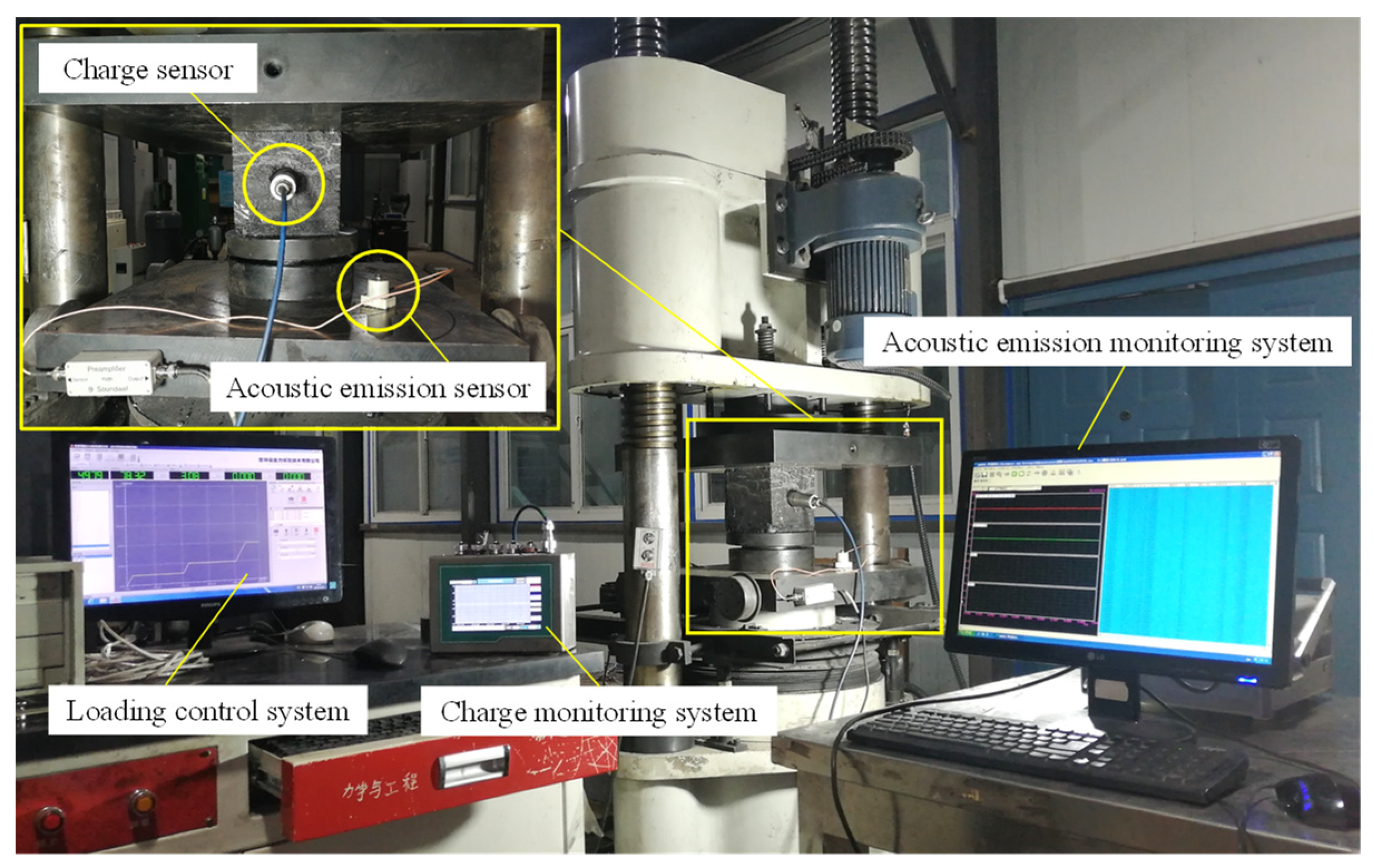
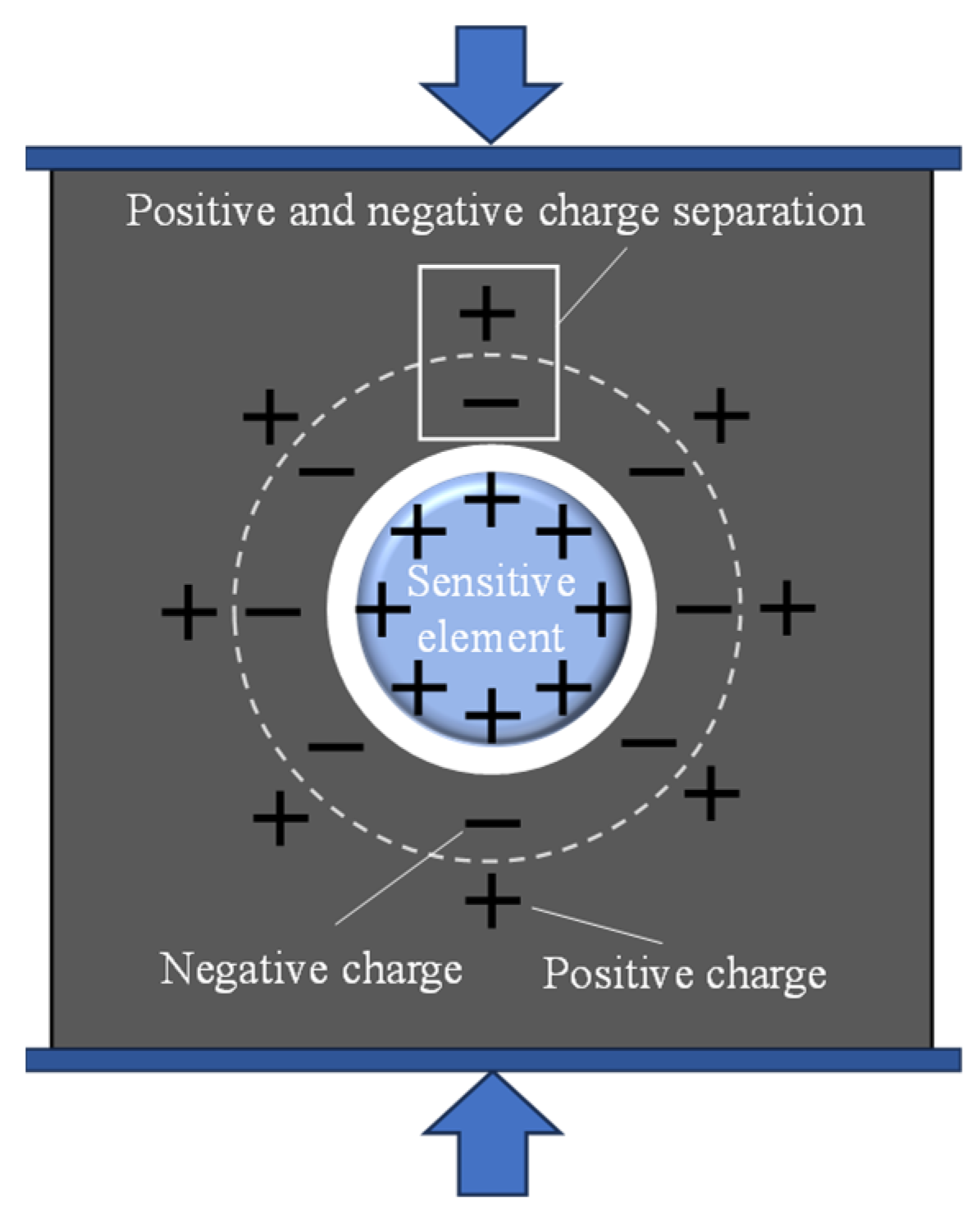

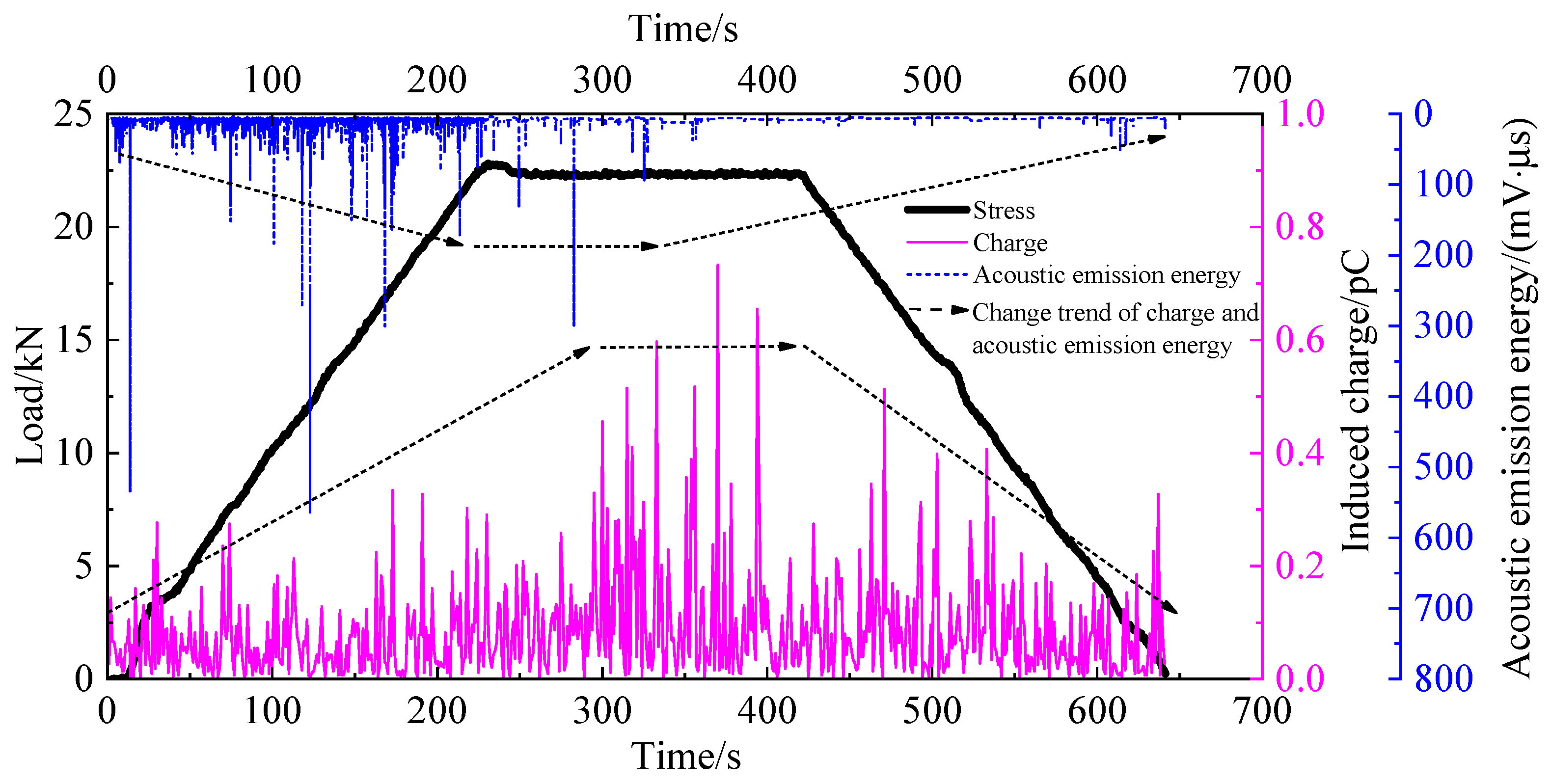


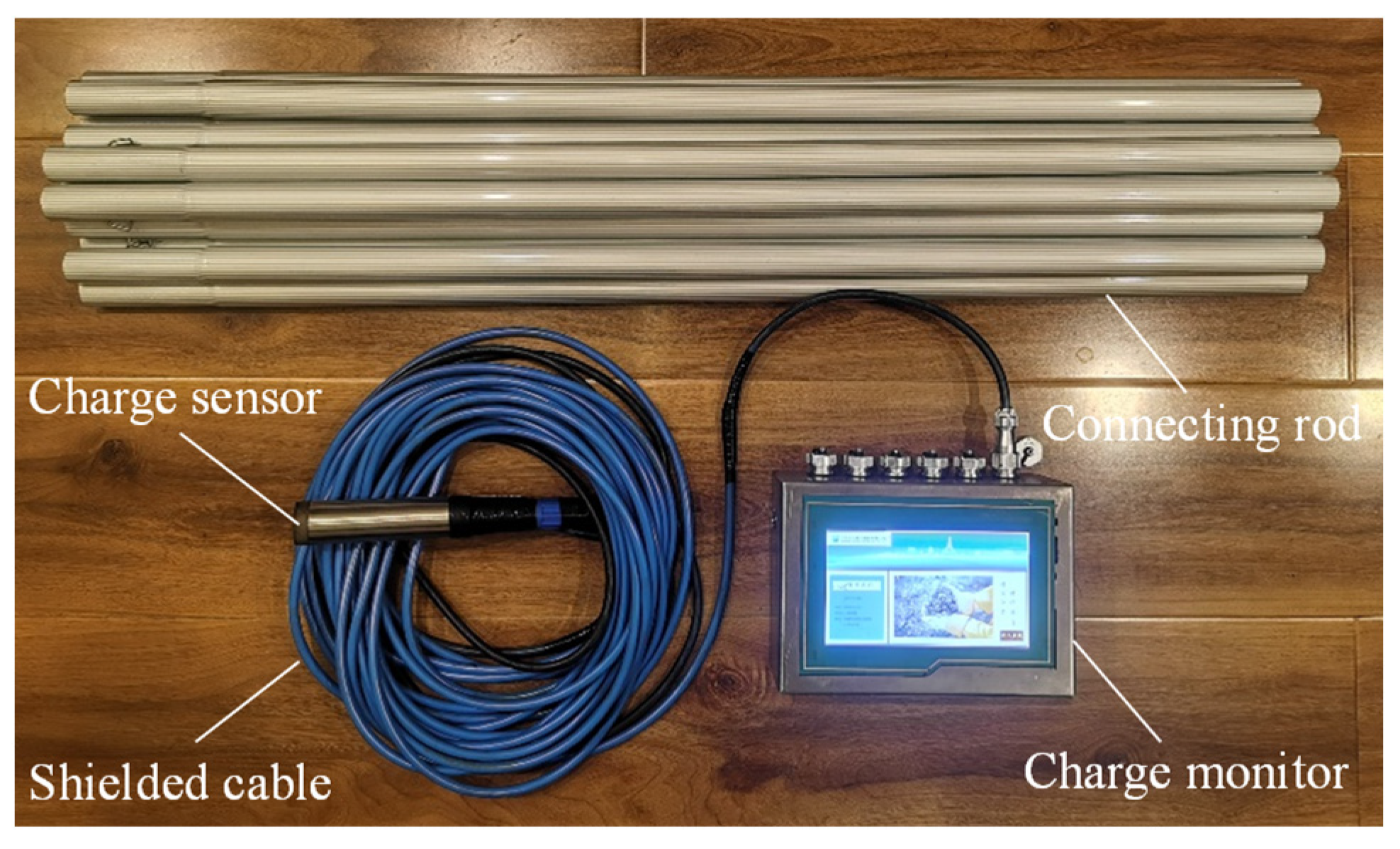
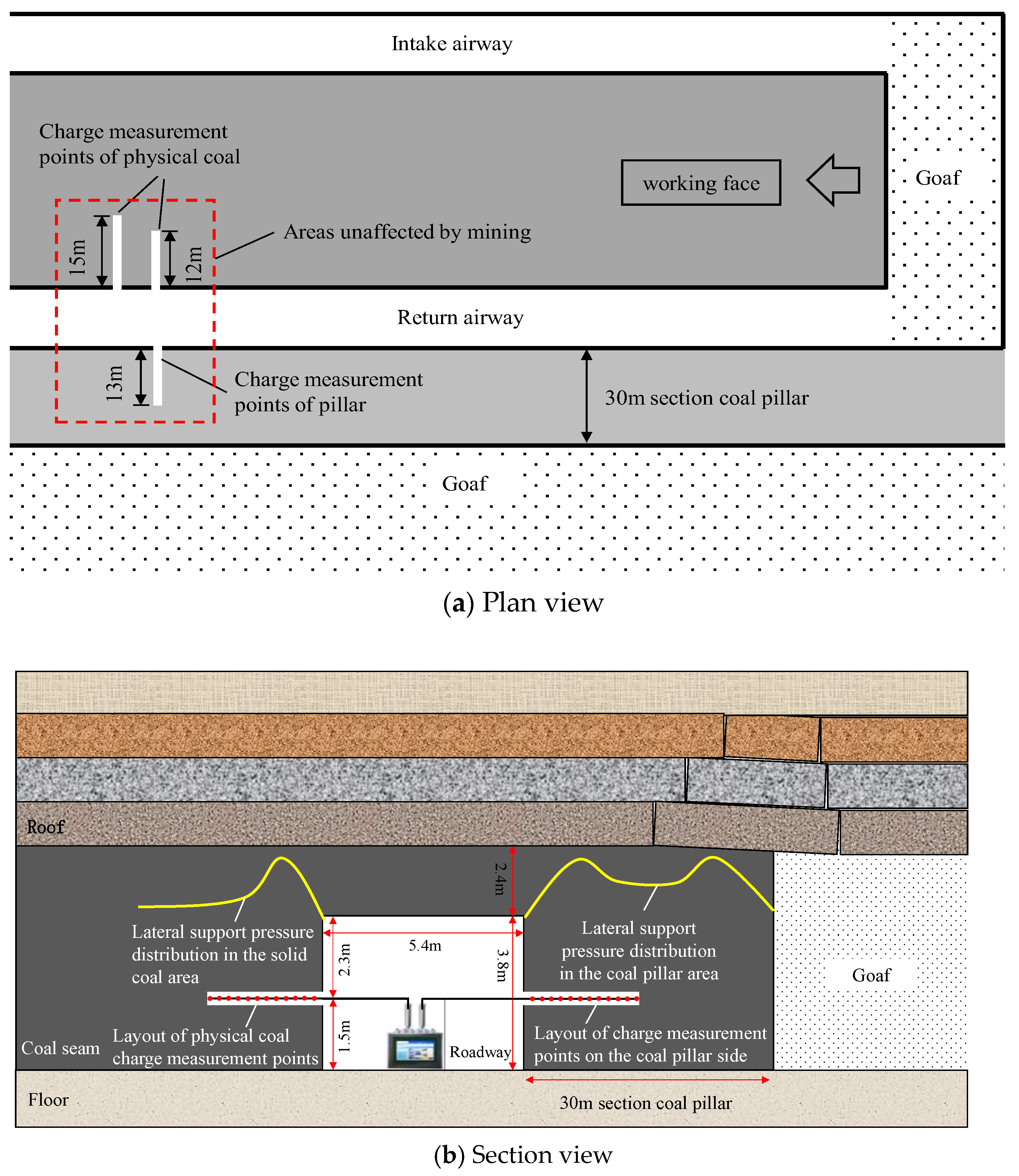





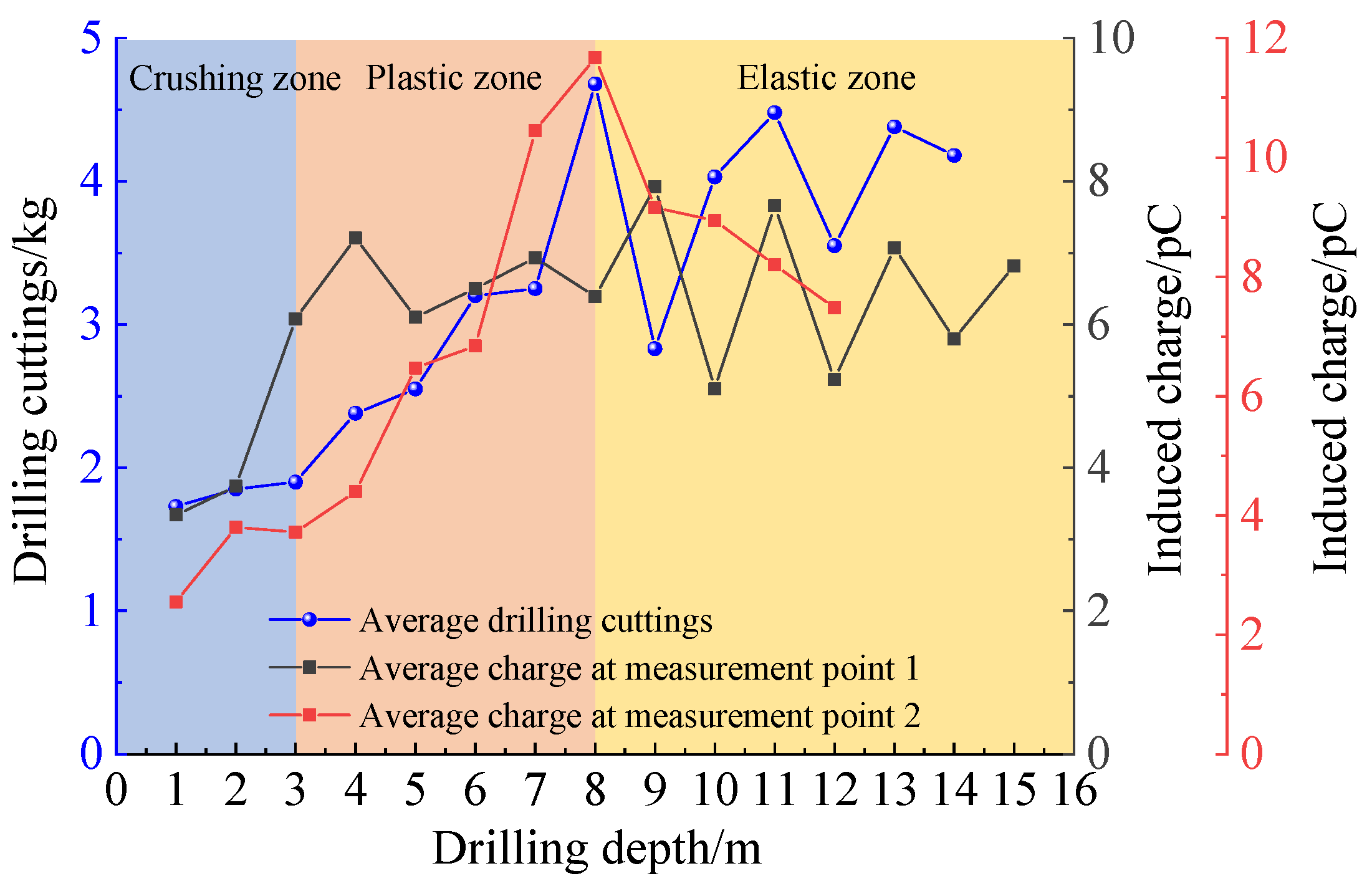
| Stress/MPa | 0 | 1 | 2 | 4 | 6 | 8 |
|---|---|---|---|---|---|---|
| Induced charge quantity of specimen 1/pC | 0.016 | 0.017 | 0.016 | 0.016 | 0.025 | 0.028 |
| Induced charge quantity of specimen 2/pC | 0.050 | 0.062 | 0.075 | 0.081 | 0.090 | 0.090 |
| Induced charge quantity of specimen 3/pC | 0.322 | 0.328 | 0.350 | 0.353 | 0.336 | — |
Disclaimer/Publisher’s Note: The statements, opinions and data contained in all publications are solely those of the individual author(s) and contributor(s) and not of MDPI and/or the editor(s). MDPI and/or the editor(s) disclaim responsibility for any injury to people or property resulting from any ideas, methods, instructions or products referred to in the content. |
© 2024 by the authors. Licensee MDPI, Basel, Switzerland. This article is an open access article distributed under the terms and conditions of the Creative Commons Attribution (CC BY) license (https://creativecommons.org/licenses/by/4.0/).
Share and Cite
Wang, G.; Du, L.; Fan, D.; Wang, A.; Shi, T.; Dai, L. Detection of Stress Distribution in Surrounding Rock of Coal Seam Roadway Based on Charge Induction Principle. Electronics 2024, 13, 3075. https://doi.org/10.3390/electronics13153075
Wang G, Du L, Fan D, Wang A, Shi T, Dai L. Detection of Stress Distribution in Surrounding Rock of Coal Seam Roadway Based on Charge Induction Principle. Electronics. 2024; 13(15):3075. https://doi.org/10.3390/electronics13153075
Chicago/Turabian StyleWang, Gang, Lulu Du, Dewei Fan, Aiwen Wang, Tianwei Shi, and Lianpeng Dai. 2024. "Detection of Stress Distribution in Surrounding Rock of Coal Seam Roadway Based on Charge Induction Principle" Electronics 13, no. 15: 3075. https://doi.org/10.3390/electronics13153075




